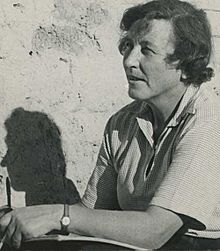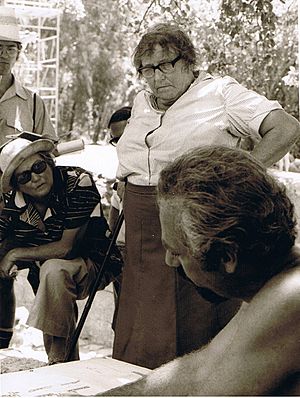Kathleen Kenyon facts for kids
Quick facts for kids
Kathleen Kenyon
|
|
|---|---|
 |
|
| Born |
Kathleen Mary Kenyon
5 January 1906 |
| Died | 24 August 1978 (aged 72) |
| Nationality | British |
| Education | St Paul's Girls' School |
| Alma mater | Somerville College, Oxford |
| Known for | Excavation of Tell es-Sultan (Jericho) Excavation of Jewry Wall Wheeler-Kenyon method |
| Scientific career | |
| Institutions | Institute of Archaeology St Hugh's College, Oxford |
Dame Kathleen Mary Kenyon (born January 5, 1906 – died August 24, 1978) was a famous British archaeologist. She studied ancient cultures from the Stone Age (Neolithic period) in a region called the Fertile Crescent. This area includes parts of the Middle East.
Kathleen Kenyon led important digs at Tell es-Sultan, which is the site of the ancient city of Jericho. She worked there from 1952 to 1958. Many people consider her one of the most important archaeologists of the 20th century. She also served as the head of St Hugh's College, Oxford, a university college, from 1962 to 1973.
Contents
Kathleen Kenyon's Early Life and Education
Kathleen Kenyon was born in London, England, in 1906. Her father, Sir Frederic Kenyon, was a well-known scholar who later directed the British Museum. Kathleen grew up in a house connected to the British Museum.
She was known for being strong-willed and determined. As a child, Kathleen was a tomboy. She loved fishing, climbing trees, and playing sports. Her father made sure she and her sister had a good education. He encouraged them to read widely and study on their own.
Kathleen was an excellent student, especially in history. She attended St Paul's Girls' School, where she was the Head Girl. Later, she won a scholarship to study history at Somerville College, Oxford. At Oxford, she was a talented hockey player. She also became the first female president of the Oxford University Archaeological Society. After graduating in 1929, she started her career in archaeology.
Adventures in Archaeology
Kathleen Kenyon's first experience in the field was in 1929. She worked as a photographer at the famous Great Zimbabwe site in Africa. After that, she joined archaeologists Tessa Wheeler and Mortimer Wheeler in England. They were digging at Verulamium, an old Roman-British town.
Working there from 1930 to 1935, Kathleen learned a lot from Mortimer Wheeler. He taught her how to dig carefully and record the different layers of soil. This method is called stratigraphic excavation. It helps archaeologists understand how old things are based on the soil layers they are found in.
Discovering Ancient Sites
From 1931 to 1934, Kathleen also worked at Samaria, an ancient city in what was then British-controlled Palestine. She dug deep trenches there. These trenches showed the different layers of history from the Iron Age to the Roman period. Her work helped date many ancient objects from the area.
In 1934, Kathleen helped set up the Institute of Archaeology at University College London. From 1936 to 1939, she led important digs at the Jewry Wall in Leicester, England. Her findings were even shown in the Illustrated London News magazine.
Unearthing Jericho's Secrets
During the Second World War, Kathleen helped the Red Cross in London. After the war, she continued her archaeological work in Britain and Libya. In 1951, she began her most famous project: excavating Jericho (Tell es-Sultan) in the West Bank.
Her work at Jericho, from 1952 to 1958, made her world-famous. She made amazing discoveries about the early Stone Age (Neolithic) cultures in this ancient settlement. She found out that Jericho was the oldest continuously inhabited place in history. This means people have lived there for thousands of years without stopping.
Kathleen also studied the pottery found at Jericho. Her work helped experts understand the dating of different periods. She also completed a book about her earlier excavations at Samaria. After Jericho, she dug in Jerusalem from 1961 to 1967. She focused on the 'City of David' area.
Kathleen believed her digs were connected to ancient stories. However, she also pointed out when her discoveries didn't exactly match some old tales. For example, she found that some ancient structures thought to be "stables" were not practical for horses. She also suggested that Jericho fell long before a famous event described in the Bible.
Kathleen Kenyon's Lasting Impact
Kathleen Kenyon greatly improved how archaeologists dig and study pottery. Her methods are still used today. An archaeologist named Larry G. Herr said that her work at Jericho changed everything. She showed how important it was to carefully separate different layers of soil. This helped archaeologists understand the age of pottery found in each layer.
Her digging methods also helped other archaeologists. They combined her careful digging with ways to study different types of pottery. This led to a much better understanding of ancient pottery in the Middle East.
However, her methods also had some challenges. Digging in narrow trenches, as she sometimes did, made it hard to understand the full picture of an ancient site. It also created a lot of data, which made it difficult to publish all her findings quickly.
From 1948 to 1962, she taught about Middle Eastern archaeology at the Institute of Archaeology in London. In 1962, she became the head of St Hugh's College, Oxford.
Awards and Recognition
In 1973, after she retired, Kathleen Kenyon was honored by the Queen. She was made a Dame Commander of the Order of the British Empire (DBE). This is a very high honor for her work in archaeology. She was also a member of the British Academy and the Society of Antiquaries of London. In 1977, the King of Jordan gave her a special award called the Order of Independence.
In her honor, the British School of Archaeology in Jerusalem was renamed the Kenyon Institute in 2003. This shows how important her work was.
Kathleen Kenyon's Collections
A collection of Kathleen Kenyon's books and papers is kept at Baylor University in Texas, USA. The objects found during her excavations are in several museums. These include the British Museum and the UCL Institute of Archaeology. Most of her other records are at the Manchester Museum.
See also
 In Spanish: Kathleen Kenyon para niños
In Spanish: Kathleen Kenyon para niños


